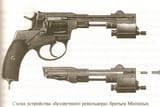Search Results
7/26/2025, 10:12:05 PM
Nagant Bramit device. Early suppressor, 1929.
>In 1929 the brothers V.G. and I.G. Mitin (Β.Γ. Mитин and И.Г. Mитин) applied for a patent under the name “Revolver for soundless shooting utilizing the principle of directing the bullet through washers of increased diameter”.
>The revolver with the silencer device required cartridges of special construction. In the case of a standard revolver cartridge was a bullet of smaller diameter (probably 5.6 or 6.35 mm) backed by a special washer (sabot). The additional muzzle cylinder mounted on the muzzle of the gun had an opening corresponding to the caliber of the bullet small enough to catch washer. When shooting the bullet with the washer moves through the barrel, but was then caught in the supplemental cylinder. The washer plugged the exit through the supplimental cylinder and the gas was retained in the volume of the barrel. This hopefully blocked the exit of powder gasses.
>During the return of the cylinder of the revolver to retracted position, the cooled powder gasses escape, making no noise. On the next shot, during the hammer cock both the revolver cylinder and the supplemental cylinder move through 1/7 revolution. After firing all seven cartridges in the revolver, the shooter had to empty the spent cartridges from the cylinder and the washers from the supplemental cylinder.
>The patent was obtained for the soundless revolver on 28 February 1931.
>In 1929 the brothers V.G. and I.G. Mitin (Β.Γ. Mитин and И.Г. Mитин) applied for a patent under the name “Revolver for soundless shooting utilizing the principle of directing the bullet through washers of increased diameter”.
>The revolver with the silencer device required cartridges of special construction. In the case of a standard revolver cartridge was a bullet of smaller diameter (probably 5.6 or 6.35 mm) backed by a special washer (sabot). The additional muzzle cylinder mounted on the muzzle of the gun had an opening corresponding to the caliber of the bullet small enough to catch washer. When shooting the bullet with the washer moves through the barrel, but was then caught in the supplemental cylinder. The washer plugged the exit through the supplimental cylinder and the gas was retained in the volume of the barrel. This hopefully blocked the exit of powder gasses.
>During the return of the cylinder of the revolver to retracted position, the cooled powder gasses escape, making no noise. On the next shot, during the hammer cock both the revolver cylinder and the supplemental cylinder move through 1/7 revolution. After firing all seven cartridges in the revolver, the shooter had to empty the spent cartridges from the cylinder and the washers from the supplemental cylinder.
>The patent was obtained for the soundless revolver on 28 February 1931.
Page 1
